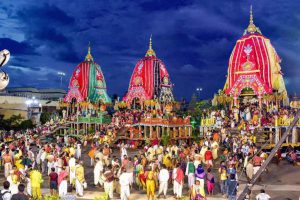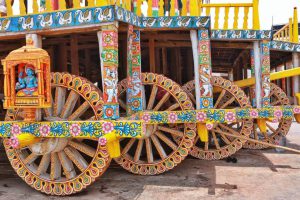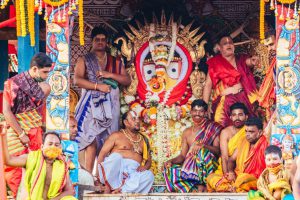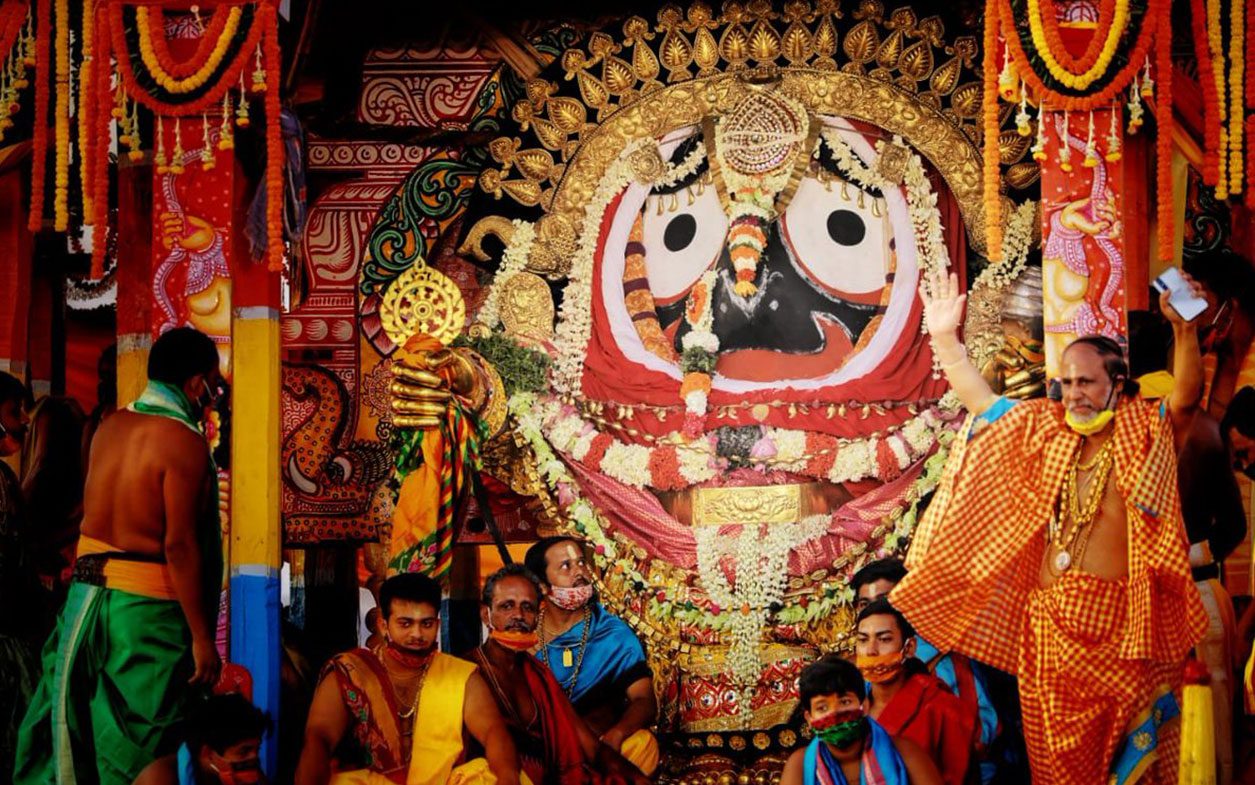
art of travel
What’s New
The Latest Product Updates from India
Compiled by Soma Paul, Product Manager, Destination Knowledge Centre
STAYS TO WATCH OUT FOR
New Hotels

- Atman by Leisure Hotels, Dharamshala, Himachal Pradesh
- Laalee, Jaipur, Rajasthan
- The Hill House Nathdwara, Rajasthan
- Zone Palace By The Park, Phalodi, Rajasthan
- Polo Floatel, Calcutta, West Bengal
- Asmi Villa, Tadoba, Maharashtra
- Maram Resort, Mamalakandam, Kerala
- The Valle, Munnar, Kerala
- The Blanket, Thekaddy, Kerala
We Are Excited About
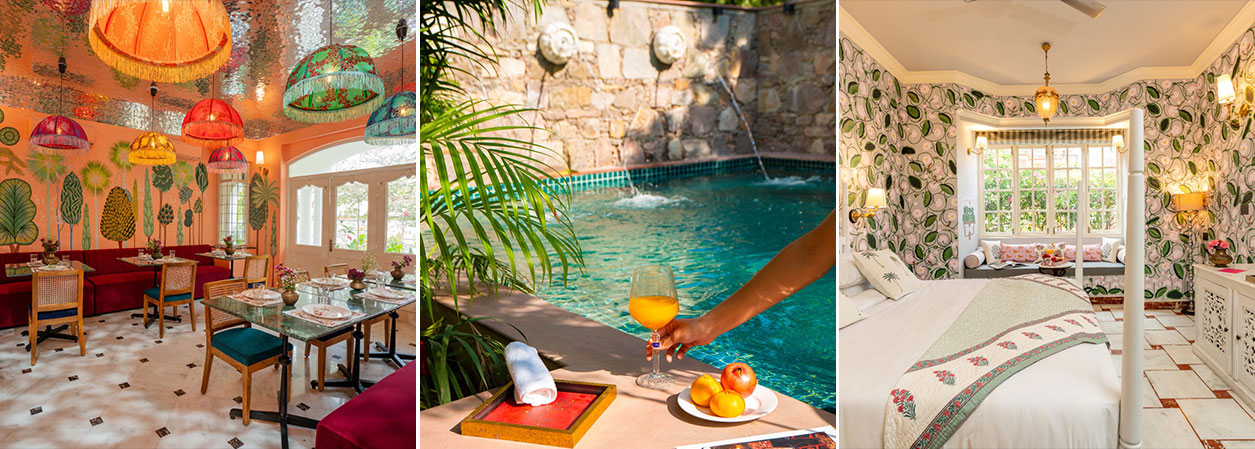
Laalee, Jaipur
Laalee is a charming blend of colonial elegance and traditional Indian culture, offering nine rooms adorned with hand-painted motifs by skilled Rajasthani artists. The hosts, Shan, an art historian and craft expert, and Devyani Bhatnagar, an excellent cook, are a dynamic duo whose diverse talents and passions enhance the Laalee experience in Jaipur. Guests can relax in the lush green garden, take a dip in the plunge pool, or enjoy a book in one of the cosy reading corners. The on-site vegetarian café adds to the charm, providing a delightful space for guests to savour local and international cuisine.
Write to your relationship manager for more details
EXPERIENCES TO WATCH OUT FOR
New Experiences

- Jaipur Our Way, Jaipur, Rajasthan
- Eat, Pray, Love, Mumbai, Maharashtra
- Stories on the Run, Chennai, Tamil Nadu
- Temple Arts of Kerala, near Muvattupuzha, Kerala
- You Catch You Cook, near Kochi, Kerala
We Are Excited About

Jaipur Our Way, Jaipur, Rajasthan (Exclusive Signature Tour)
Not just a Haveli or Temple Tour – this exclusive tour offers a cohesive narrative that captures the essence of Jaipur’s city planning. Themes of power, kingship, and art are brought to life through engaging interactions, workshops, and storytelling.

You Catch You Cook, near Kochi, Kerala
This experience provides a fascinating glimpse into the unique way of life on the living islands near Kochi, offering a rare opportunity to connect with the vibrant local community. Feel the thrill of fishing alongside the villagers as you cast nets, prepare your own lunch, and conclude the experience with a scrumptious meal.
Write to your relationship manager for more details
ITINERARY OF THE MONTH
Bengal and Sikkim
Kolkata – Kalimpong – Gangtok – Temi Tea Estate – Pelling – Darjeeling – Kolkata
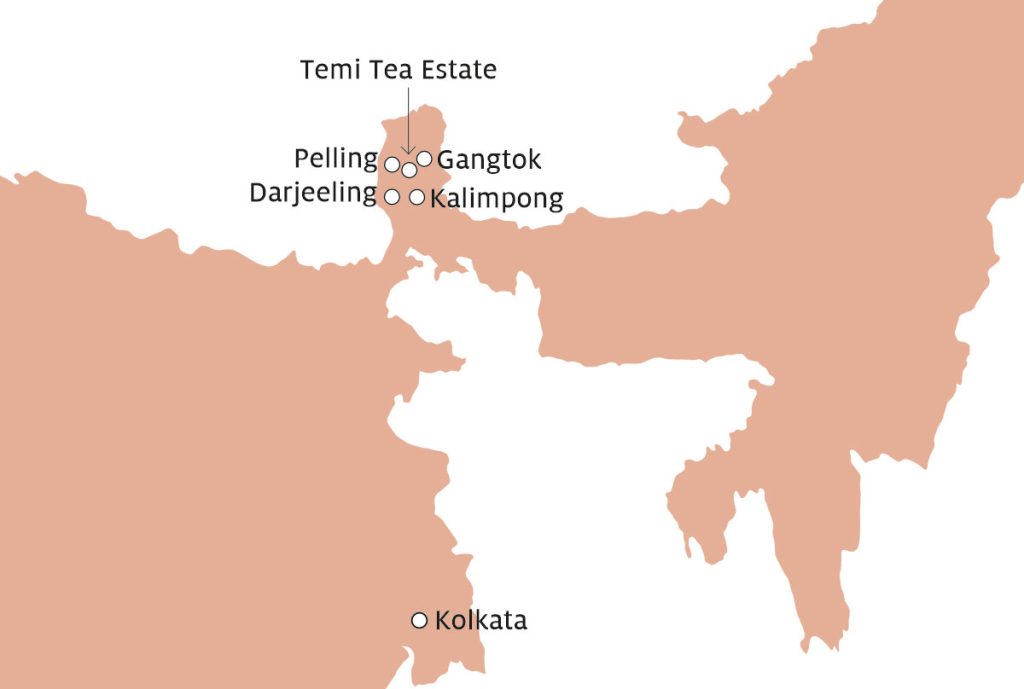
Highlights of the Tour

- Discover Kolkata; chaotic but irresistibly charming through the eyes of locals
- Enjoy Baul music at an ‘Adda’ session with locals in Kolkata
- Discover Rural Kalimpong on Foot.
- Explore the Rumtek Monastery in Sikkim, the largest and wealthiest monastery in India.
- Stay at the breathtaking Temi Tea Estate in Sikkim
- Take an early morning walk from your hotel to witness the splendid sunrise over Mt. Kanchenjunga. Get blessed at the Mahakal Temple on your way back.
- Enjoy an extended ride on the Darjeeling Himalayan Railway from Kurseong to Sukna
Write to your relationship manager for the detailed itinerary
PARTNERS IN CHANGE
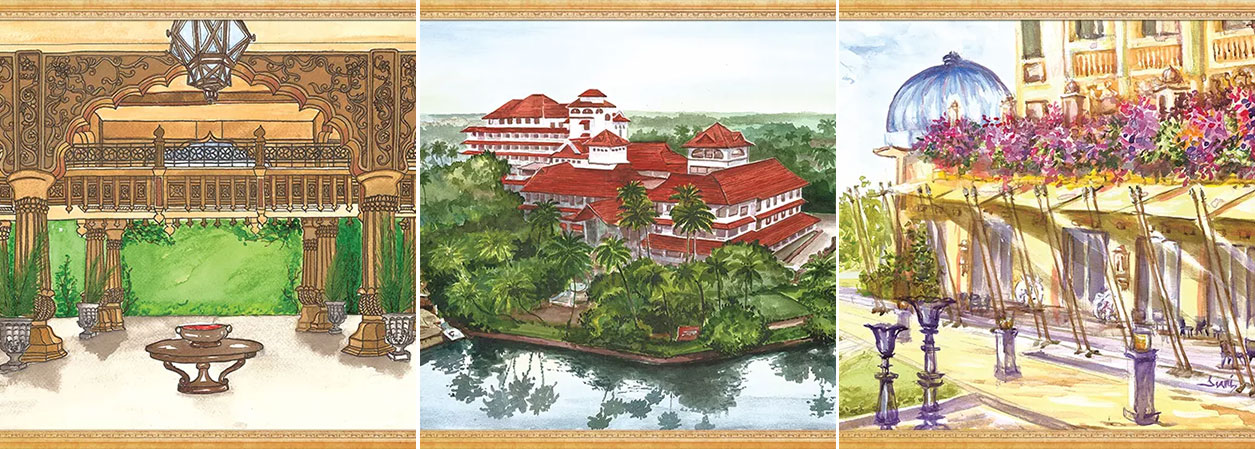
The Leela Palaces, Hotels and Resorts
The understanding of luxury has evolved over time from being only material focused to being more humane. The Leela Group has recognised this shift and extended their commitment to a deeper connection with nature and communities.
To kick start the year 2024, they collaborated with twelve exceptionally talented Mouth and Foot Painting Artists (MFPA) for creating artistic illustrations of their twelve hotels to form a part of The Leela 2024 calendar. Conceptualised with the theme ‘Coming together to do good at The Leela’, each month in the calendar uncovers the extraordinary charm of fine art.
Guided by principles of environmental sensitivity, responsible consumption, and resource efficiency, they have implemented a range of eco-friendly initiatives that span waste reduction, energy conservation, and responsible sourcing. Operating Windmill and Solar plants in Bangalore, Chennai, Jaipur, and Udaipur, they have achieved a remarkable reduction of 15,485 tonnes of carbon emissions annually. This is equivalent to planting over 1,100,000 trees each year.
The Leela Udaipur is the only hotel to operate EV boats on Lake Pichola with 6 environment-friendly 18-seater boats equipped with cutting-edge green technologies reducing 98 tonnes of carbon emissions.
In their commitment to a circular economy, the luxury hotel brand has collaborated with Phool, a natural incense stick manufacturing company that employs women from marginalised sections of the community and offers them a fair wage. Phool transforms the flowers used at various Leela properties into charcoal-free incense sticks and cones that do not produce harmful toxins when burnt, reducing waste and eliminating pollutants.
The ‘Shefs at The Leela’ program celebrates Indian women chefs, whereas their #IAmLeela campaign highlights the extraordinary journeys of women at The Leela, showcasing their achievements and empowerment within the brand.
RARE: A Hero’s Journey Award
We are very happy to collaborate with RARE India to give away the RARE: A Hero’s Journey award to Utsav Camp for their efforts in bringing Sariska back to the tourist map, promoting environmental stewardship, empowering local communities, and implementing sustainable initiatives.
Luv Shekhawat, the owner of Utsav Camp, has shown a strong commitment to sustainability and adopted practices tailored to the destination and community. The once-empty parcel of land in Tehla, Sariska, has been transformed over the years through careful cultivation, aiming to mitigate environmental impact and create lasting positive change for future generations. This has not only attracted wildlife and nature enthusiasts to the area but has also been instrumental in retelling the story of the historical and heritage sites in the region. Furthermore, Luv has prioritised hiring and training local community members, instilling a sense of ownership and environmental stewardship in them.
We congratulate Luv Shekhawat for his sustainable efforts in creating a planet-sensitive and community-inclusive haven in Sariska.
Stay tuned for our yearlong showcase of Utsav Camp’s inspiring journey in our Sustainability and Us Section.
Write to your relationship manager for more details
Stories from India
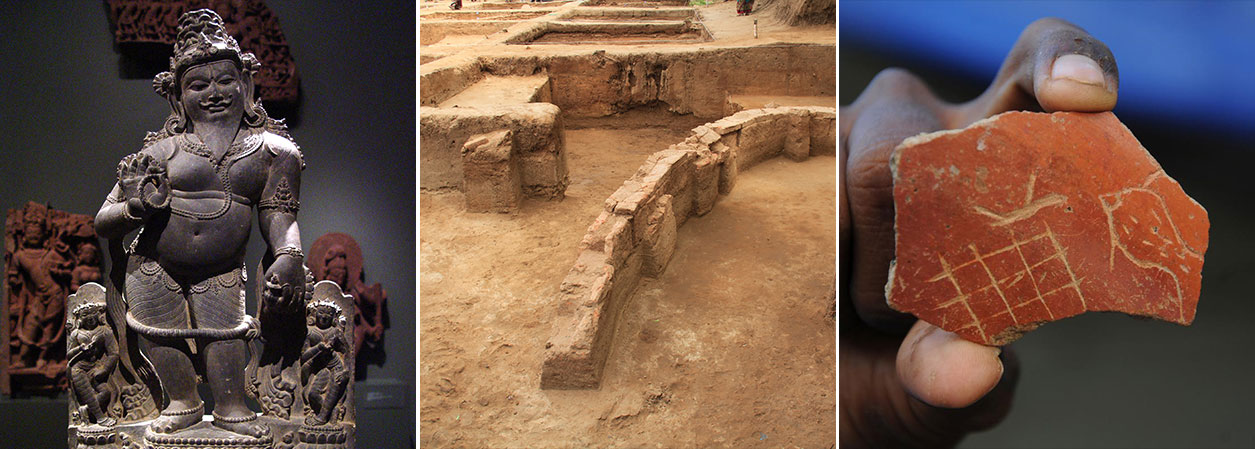
Sangam Literature and Ancient Tamil Nadu
From the Research Hub of the Destination Knowledge Centre
The 2000-year-old Sangam literature is the earliest known example of literature in South India. Written in the classical Tamil language, Sangam literature contains 2381 poems by 473 poets, with some 102 being anonymous. This remarkable corpus of poems, written by both male and female poets from a variety of professions and social strata, offers a fascinating peek into the life and times of ancient Tamil Nadu and trade relations between South India and the Mediterranean, West Asia, and Southeast Asia.
For starters, in Sangam literature, ancient Tamil Nadu is divided into five landscapes: Kurinji (mountain), Mullai (forest), Marutham (agricultural land), Neithal (coastal region), and Palai (desert). What makes Sangam literature unique are the tales about common people. The narratives are about family, love life, nature-oriented lifestyle, women of society, heroism in the battlefields, warfare, seafaring, and trade in ancient times. Many of the Sangam poets were Jains, whose philosophy of non-violence had inspired Mahatma Gandhi in his passive resistance against the British Raj. Another fascinating thing that Sangam literature tells us about ancient Tamil Nadu is that it didn’t have grand temples. Every king or country had a tree which was believed to be the abode of a guardian angel worshipped as a protector deity. When a king defeated another in battle, the first thing destroyed was the tree of the protector deity, and a battle drum was made out of it as a trophy of victory.
There are also elaborate tales about the food habits of the five landscapes in Sangam literature, which are very distinct to the topography. Couplets by Sangam poets talk about people of Marutham (agricultural land) eating white rice with a thick pasty curry made of crab flesh and gourd. A wide variety of rice, meat, spinach, vegetables, puffed rice, pulses, cereals, legumes, and pickles find mention as staples in the diet of the Marutham people. Whilst the Kurinji (Mountains) people ate tubers and honey, the Mullai (Forest) people hunted wild boars and cooked the meat on fire. Very interestingly, each landscape had its own cooking style. The people of Kurinji (mountains) and Mullai (Forest) cooked their food on fire. Frying and sun-drying were common in the Palai (desert) and Neithal (coastal) regions. Food habits of ancient Tamil Nadu, which find mention in the Sangam literature, range from the ordinary millet in the Mullai region to the exotic tender pomegranate seeds sautéed in ghee (clarified butter) in the Marutham region to the bizarre and outrageous – rat meat and monitor lizards cooked in ghee (clarified butter) – in the Kurunji region.
Write to your relationship manager for more details
Sustainability and Us

Stepwells and Water Bodies of Jodhpur
Excerpts from the Bridge the Knowledge Gap Rajasthan Study Tour Report.
Jodhpur is world famous for the magnificent Mehrangarh Fort, the bustling clock tower market, and the blue houses of the priestly class. It is also considered the gateway to the Great Indian Thar Desert with scorching temperatures for most of the year and was once the capital of the state of Marwar (meaning the land of the dead) of princely Rajasthan or Rajputana. However, not too many know that Jodhpur is also renowned for its stepwells and water bodies, locally known as Baoris or Jhalra. Records in the royal court of Jodhpur mention more than 50 stepwells and around 200 wells that supplied water to Jodhpur throughout its history. Some of them are today listed in the INTACH’s (The Indian National Trust for Art and Cultural Heritage) inventory of heritage sites.
These stepwells and wells are typical examples of what happens when culture, utility, and sustainability are interwoven by a community. Stepwells were primarily used as water reserves in western India, mainly in Rajasthan and Gujarat, where water levels and rainfall are very low. Only for a month or two does this drought-prone region receive scanty rainfall, and most stepwells were constructed to store rainwater. To keep the surroundings clean, temples were built in and around the stepwells, serving as places to socialise and provide shelter to weary travelers. Of course, we have the Chand Baori enroute from Agra to Jaipur and the Rani-ka-Bhav in Gujarat which are no less than works of stunning art, the latter being a UNESCO World Heritage site.
One such lesser-known water body in Jodhpur is Jeta Bera (Bera means well in the local language), situated in the Brahmpuri area of the walled city, also famous for its blue houses. During the time of the Maharajas of Jodhpur, water from Jeta Bera was strictly rationed, and records at the Mehrangarh Fort still show receipts issued to obtain water from this well. It is believed that Jeta Bera is as old as Jodhpur city, dating back to the 15th century. Until 1950, water from Jeta Bera was used only by the royal family of Jodhpur and medical practitioners. No one else was allowed to take water from this well without permission from the royal court. The locals still use it for drinking purposes, believing it has medicinal value.
Built by members of the royal family and wealthy merchants, these water bodies have fascinating stories too!
For those interested in a walk through the walled city after visiting the Mehrangarh Fort, Ranisar and Padamsar are two historic water reservoirs quietly tucked away at the foothills. It is said that Padamsar was built by Queen Padam Ji Deora, a princess from Sirohi. However, locals tell a different story. In the 16th century, Marwar faced a series of droughts and a significant shortage of funds needed to strengthen the army to protect the region from foreign invasions. The head of the royal army of Jodhpur kidnapped Seth Padam Ji, a wealthy and influential merchant from the Mewar region (now Udaipur). The ransom demanded for his release was nine hundred thousand gold coins. The merchant agreed, and when finally released, he requested the royal court of Jodhpur to immortalise his name, having paid such a substantial sum for his freedom. Hence, Padamsar, according to locals, was constructed and named after the rich merchant.
Another favourite water body of ours is the Gulab Sagar Lake. A sunny winter lunch after the city tour of Jodhpur at the rooftop café of Pal Haveli, offering great views of Gulab Sagar Lake, is highly recommended. It was commissioned by Gulab Rai in the 18th century who was a concubine of Maharaja Vijay Singh. She also commissioned a Temple – Kunj Bihari Ji ka Mandir- and a stepwell, showcasing early practices of sustainable urban planning.
Stepwells in Jodhpur have not lost their relevance even today. The most recent example is the Birkha Bawari, designed by a local architect in 2009. The structure was designed to store water, built in the traditional style with red sandstone. Birkha Bawari can hold 17.5 million litres of rainwater, currently providing water to the upscale Umaid Heritage Housing Township of Jodhpur, demonstrating sustainable water management practices.
Today, Jodhpur’s historic stepwells are being restored to their former glory. The Toor-ji-ka-Jhalra near Hotel RAAS in the old city is a fine example. We recommend a cup of coffee at the Stepwell Café overlooking Toor-ji-ka-Jhalra, blending history, culture, and sustainability in perfect harmony.
BTKG is an annual summer training programme that the Destination Knowledge Centre has been organising since 2017 to empower, educate and share the collective knowledge of our in-house Explorers with the Tour Operations staff.
Explore
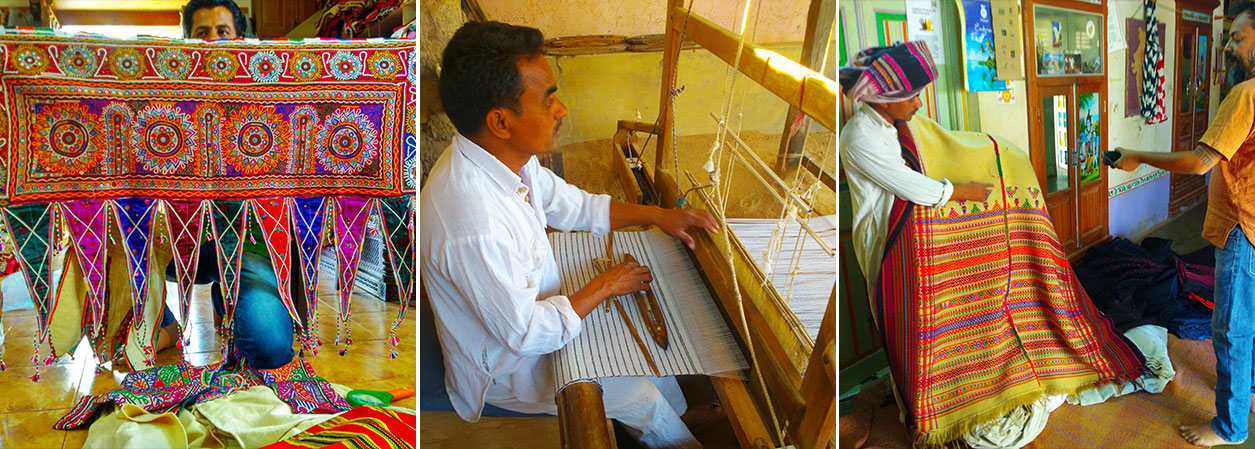
Banni, Asia’s largest Grassland – the Cradle of Beautiful Textile and Craft Tradition
From the Travel Diary of Kuntil Baruwa, Explorer, Destination Knowledge Centre
Banni is Asia’s largest Tropical Grassland. It covers an area of 2500 square kilometers (some say more, some much less) and is located on the rim of the marshy salt flats of the Great Rann of Kutch in Gujarat. 30 years ago, it is said, the grass here used to grow so tall that you wouldn’t spot a herd of buffaloes walking around. This is a difficult image to conjure for anyone encountering Banni for the first time. Some may even ask why it is even called a grassland for it is unlikely that there will be much grass in sight during season time (Oct to March). But wait till monsoon. As far as you can see, it’s just water and grass. “Indeed difficult to imagine on a particularly hot sweltering day in April when I encountered burning winds and intermittent dust storms that left a fine layer of mud, sand, and salt on my skin and in my teeth,” says Kuntil Baruwa from our Destination Knowledge Centre.
Their Stories
Very interestingly the locals call these dust storms “Laat” (meaning long tresses in the local Kutchi language). They say that these dust storms happen when Mother Nature tosses her head gently sending her beautiful tresses bouncing all over Banni. The intriguing field of narrative psychology is telling us only now that if we interpret the events of our life to mean that we are lucky or wise, it will be easy to look optimistically at the future. But for the people of Banni, it has been a way of life for centuries. They figured out long ago that the stories they tell about themselves and what they encounter in this harsh terrain are the key to their well-being.
Their Inspirations
For a city dweller, the thorny Babool (Acacia Nilotica/Gum Arabic) Tree – which makes for a good hedge for agricultural fields to keep out grazing animals and was once found all over Banni – is not worth a second look. But the women of Banni took this rather ugly-looking and uninteresting tree as an inspiration for the most common motif of their embroidery called TAK BAVARIYO – it is a circle that is framed on both sides by an hourglass symbol. The circle is known as TAK which has a MIRROR piece- called ABLA in the local parlance – and the hourglass symbol resembles the branches of the thorny Babool tree – called BAVARIYO, again in the local language.
In Banni the leaves of the Babool tree are used to treat infertility in women, flowers for hepatitis and jaundice, and bark for mouth blister and heat stroke. It is fascinating how despite not knowing how to read or write, women from across all communities in Banni have effortlessly translated their culture and visual stimuli into a glorious needlework tradition.
A Unique Socio-Cultural-Economic Web
And now Imagine this. Imagine, for more than 500 years or so, not one but 22 different communities of pastoralists with their cattle, buffaloes, sheep, and goats – each with their distinct identity – living in complete harmony with their surroundings. Imagine these hardy people as the reason and the inspiration behind some of the most beautiful textile and craft traditions. The complex, yet beautiful geometric designs of Ajrakh, for example, were originally meant for the turbans, stoles, and lungis (a garment worn around the waist) of the cattle and buffalo herders of the Maldharis, Rabaris, and Ahir communities of Banni. What the Ajrakh artisans – the Khatris, who came to Kutch some 400 years ago or so from Sindh (now in Pakistan) – got in return then was milk, butter, ghee (clarified butter), curd, and other milk products. Likewise, the Rabaris and the Ahirs went to the weavers of the Maheshwari community with goat and sheep wool to get their shawls weaved. In return the Maheshwari weavers were given land on lease to grow cotton and also milk products. And should the Maheshwari weavers want something printed on their hand-woven shawls, they will send it to the Khatris in exchange for goods. There are many such examples of this fascinating, unique, socio-cultural-economic web that once existed where bonds were forged between various communities for generations.
But what is the upside to the 2001 Earthquake in Gujarat?
It was probably one of India’s worst natural disasters. It caused countless deaths mainly in the Kutch region of Gujarat and incredible human suffering. So what could be the upside to this tragedy? “When my Guide posed this question about what I thought could possibly be the positive side to the Earthquake I was a bit annoyed. But got curious when he continued to share how his own house was completely demolished, how his family escaped by the skin of their teeth, and that he lost his best friend,” says Kuntil Baruwa from our Destination Knowledge Centre. So what could be the upside to this tragedy that left 22,000 people dead, destroyed close to 400,000 houses, and rendered more than 600,000 people homeless? All the textile and craft tradition that our guests now experience in Banni is a result of the huge surge of collective energy post the 2001 earthquake. The calamity forced the communities to reflect urgently on their situation and they realised that it is their craft – local and unique – that can help tide over their seemingly hopeless situation. It also brought aid and the attention of the world to Kutch, raising funds as well as awareness for the local art and craft.
And indeed…
Had the 2001 earthquake not happened, the weaving tradition of Kharad – a unique and rare style of rug weaving- that uses the hair of sheep, camel, and goat would have stayed in Kuran – a nondescript remote village in the India-Pakistan border. When the earthquake devastated his home, Kharad weaver Tejsi Bhai migrated from Kuran leaving everything behind, including age-old trade relations. He brought with him the only thing he knew – Kharad weaving- which ran in his family for 8 generations – done on a loom made of tree branches.
Write to your relationship manager for our 6 nights/7 days Textile and Craft Itinerary of Banni, Gujarat
Inspiration

Film Review by Inderjeet Rathod, Product Manager, Destination Knowledge Centre
MANTHAN (1976)
Directed by Shyam Benegal
Manthan (meaning ‘The Churning’) is an iconic film directed by Shyam Benegal, one of the founding members of Indian parallel cinema. It won the National Award for Best Hindi Feature Film, and was India’s submission to the 1976 Oscars. The story of Manthan is inspired by the pioneering milk cooperative movement of Verghese Kurien, the father of the White Revolution in India.
The film depicts the experiences of a young Veterinary Doctor, Manohar Rao, who is posted to a remote village in Gujarat to set up a Milk Cooperative Society. The majority of the villagers, who are from a low caste, sell their milk to a privately owned dairy that pays them a meagre price. By explaining to the villagers that a cooperative society will get them higher earnings and also improve their socio-economic status, Manohar Rao and his team of three other members upset all existing socio-economic equations in the village. This is obviously met with a lot of mistrust and scepticism from all sides and creates a churning of sorts — the lower caste community members are afraid that the society will be taken over by the upper caste; the dairy businessman is afraid he’ll face losses in his business and gradually lose his reputation in the village; the Sarpanch (Village Head) wants to take advantage of the churning to win an election. The film meticulously details how Manohar Rao and his team try to break through the age-old old socio-economic structure, despite many obstacles.
Manthan is an iconic film for multiple reasons. Firstly, it is a stellar cast with some of the best actors in Indian parallel cinema. Secondly, the director and the technicians have meticulously highlighted rural Gujarat, its landscape, its socio-economic structure, and its culture. Thirdly, the film was crowd-funded by about 500,000 dairy farmers of Gujarat Cooperative Milk Marketing Federation Ltd for the benefit of the rest of India to adopt cooperative milk production.
Today Gujarat Cooperative Milk Marketing Federation Ltd is a pioneering business making a positive impact on the value chain where its sourcing, operations, social engagement, and customer support are all driven by sustainability, and by being competitive and contemporary in its business practices. Its flagship AMUL is considered the national brand of India’s dairy products.
On May 17, 2024 a 4K restoration of Manthan was screened at the Salle Buñuel theatre of the Cannes Film Festival. The film was restored and digitised from its original camera negative over a 17-month period. The Gujarat Co-operative Milk Marketing Federation funded the restoration.
Festival to Watch Out For
The Jagannath Rath Yatra
07 July, 2024
From the Festival Calendar of the Destination Knowledge Centre

The Jagannath Rath Yatra is a vibrant and grand festival celebrated in the temple town of Puri in the state of Odisha, in India’s East Coast.
Picture this: it’s a sunny day in Puri, and the streets are lined with hundreds of thousands devotees from all walks of life. Now, imagine people pulling towering chariots, resembling those from ancient Roman triumphal processions, adorned with colorful banners, flowers, and flags. These magnificent chariots carry the idols of Lord Jagannath (an incarnation of the Hindu deity Vishnu), his brother Balabhadra, and their sister Subhadra.
As the procession begins, the air is filled with the rhythmic beats of drums and cymbals, similar to the traditional festive music heard during the Chinese New Year parades in Hong Kong.
The Jagannath Rath Yatra is not just a religious festival; it’s a celebration of community, culture, and diversity. It brings people together from all corners of Odisha, India, and the globe, much like the multicultural gatherings at the famous Gion Matsuri festival in Kyoto, Japan. It’s a time of joy, unity, and reverence, where people of different backgrounds come together to celebrate the divine and embrace the spirit of togetherness.
Write to your relationship manager for a copy of our Festival Calendar (2024-25)
RESOURCES
SITE LINKS
CONTACT US
+ 91 (124) 4563000
Tower B, Delta Square, M.G. Road, Sector 25, Gurgaon - 122001, Haryana, National Capital Region of Delhi, India







